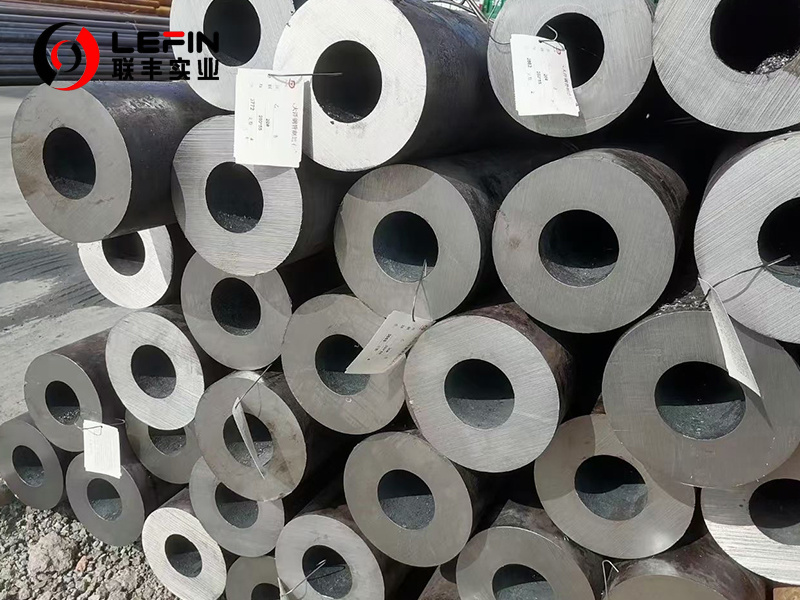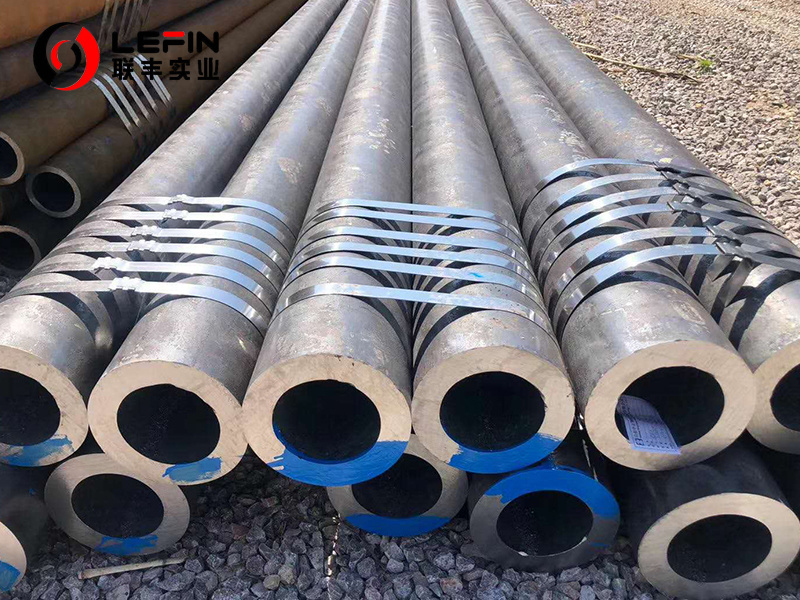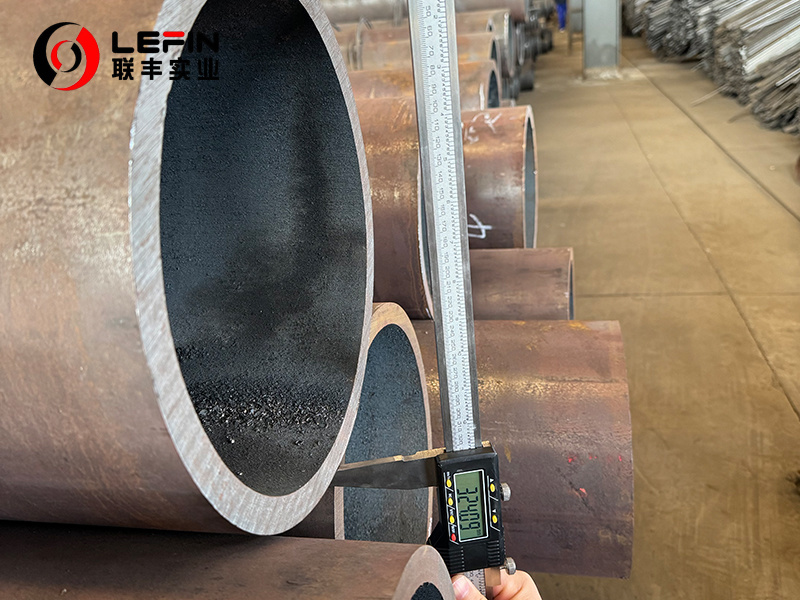



- Details
-
Basic Information
ASTM A106 Grade A is a type of seamless carbon steel pipe designed for high-temperature and high-pressure applications. It is part of the ASTM A106 standard, which covers seamless carbon steel pipes for service at elevated temperatures. The "A" designation in A106 signifies its material composition, primarily containing carbon and manganese. This grade is characterized by a carbon content of 0.25% maximum, which ensures its suitability for high-temperature service. The manganese content ranges between 0.27% to 0.93%, providing excellent formability and weldability.ASTM A106 GR.A SEAMLESS PIPE
STANDARD: ASTM A106/A106MGRADE: GR.A, GR.B, GR.C
Outside Diameter:Ranging from NPS 1/8 to NPS 48 (DN 6 to DN 1200)
Wall Thickness:
Nominal (average) wall thickness as specified in ASME B36.10M.
Length: Commonly used 5.8M, 6M, 12M, but we can also produces depends on client's requirement.Test: Hydrostatic testing, Non-destructive electrical testing, and Mechanical testing
Applications: Oil and gas sector, Construction industry, Power industry.
CLICK HERE➡ASTM A106 SEAMLESS PIPES
Chemical RequirementsComposition,%
Grade A Carbon,max 0.25A Manganese 0.27-0.93 Phosphorus,max 0.035 Sulfur,max 0.035 Silicon,min 0.10 Chromium,maxB 0.40 Copper,maxB 0.40 Molybdenum,maxB 0.15 Nickel,maxB 0.40 Vanadium,maxB 0.08 A For each reduction of 0.01% below the specified carbon maximum,an increase of 0.06% manganese above the specified maximum will be permitted up to a maximum of 1.35%.
B These five elements combined shall not exceed 1%.● Grade A: It has a maximum carbon content of 0.25%. The manganese content ranges from 0.60% to 1.35%. Phosphorus is limited to a maximum of 0.040%, and sulfur is controlled at a maximum of 0.045%. The relatively low carbon content helps maintain good ductility for fabrication processes.
Tensile Requirements
Grade A Tensilestrength,min,psi [MPa] 48000 [330] Yield strength,min,psi[MPa] 30000 [205] Elongationin 2 in.[50 mm],min,%: Longitudinal Transverse Basic minimum elongation transverse strip tests,and for all small sizes tested in full section 35 25 When standard round2-in.[50-mm]gauge length test specimen isused 28 20 For longitudinal strip tests A
For transverse strip tests,a deduction for each 1/32-in.[0.8-mm] decrease in wall thickness below 5/16 in.[7.9 mm]from the basic minimum elongation of the following percentage shall be made
1.25 A The minimum elongation in 2 in.[50 mm]shall be determined by the following equation: e=625000A0.2/U0.9
for inch-pound units, and e=1940A0.2/U0.9for SI units, where: e =minimum elongation in 2 in.[50 mm],%,rounded to the nearest 0.5%,
A=cros-sectional area of the tension test specimen,in²(mm²),based upon specified outside diameter or nominal specimen width and specified wall thickness, rounded to the nearest 0.01 in²[1 mm²].(if the area thus calculated is equal to or greater than 0.75 in.2 500 mm²,then the vaue 0.75in2 [500 mm²]shall be used.),and U =specified tensile strength,psi [MPa].● Grade A: It has a minimum yield strength of 30,000 psi (205 MPa) and a minimum tensile strength of 48,000 psi (330 MPa). Grade A is designed for general purpose applications where moderate strength is required.
Applications● Power Generation: A106 Grade A pipes are commonly used in power generation plants to transport steam, which is a crucial component in power generation processes. They are designed to withstand the high temperatures and pressures inherent in these environments.
● Oil and Gas Industry: These pipes are extensively used for the transportation of petroleum and natural gas. Their ability to withstand harsh environmental conditions and varying pressures makes them an ideal choice in this industry.
● Chemical Processing: In chemical processing plants, where corrosive substances and extreme temperatures are prevalent, A106 Grade A pipes play a vital role in conveying chemicals safely and efficiently.
● Construction: The construction industry relies on A106 Grade A pipes for structural applications. Their strength and durability make them suitable for supporting heavy loads and ensuring the integrity of structures.Advantages
● Reliability: A106 Grade A pipes are renowned for their reliability under high-temperature and high-pressure conditions. This reliability is crucial in industries where the failure of a pipe can have severe consequences.
● Versatility: The versatile nature of A106 Grade A pipes, stemming from their excellent weldability and formability, makes them adaptable to various fabrication processes and applications.
● Cost-Effectiveness: As a cost-effective solution, A106 Grade A pipes provide a balance between performance and affordability, making them a preferred choice for many industries.
● Weldability: A106 Grade A pipes are relatively easy to weld compared to other materials like stainless steel or high-alloy pipes. They can be welded using common welding methods such as TIG (Tungsten Inert Gas) and MIG (Metal Inert Gas) welding. This makes them highly adaptable to various fabrication needs, including complex pipe systems or custom fittings.
● Heat Resistance: These pipes are capable of withstanding hot fluids, steam, and gases at temperatures up to 750°F (400°C). This is crucial in industries such as power generation and refining, where hot and pressurized substances are constantly in motion.
● Pressure Resistance: With the right grade, A106 pipes can handle pressures up to several thousand psi. This is particularly important in industries like oil and gas, where pipelines often operate under very high pressure, both onshore and offshore.
Manufacturing
Seamless Pipe Production● Billet Preparation: High-quality steel billets are selected based on the chemical composition requirements of the specific grade. The billets are heated to a suitable temperature, usually around 2200 - 2400°F (1200 - 1300°C), to make the steel more ductile.
● Piercing Process: The heated billet is pierced through the center by a piercing mill, forming a hollow shell. This process requires precise control of the piercing angle and speed to ensure uniform wall thickness.
● Rolling and Reducing: The hollow shell is then rolled and reduced in diameter through a series of rolling mills. The mills gradually shape the pipe to the desired size and wall thickness. During this process, the pipe is continuously cooled to maintain its structural integrity.
● Heat Treatment: After rolling, the pipe may undergo heat treatment such as normalizing or tempering. Normalizing involves heating the pipe to a specific temperature and then cooling it in air, which refines the grain structure and improves mechanical properties. Tempering is used to relieve internal stresses and enhance toughness.
ASTM A106 Grade A pipes are a reliable and cost-effective solution for a wide range of industrial applications. Their ability to withstand high temperatures and pressures, combined with their excellent weldability and versatility, makes them a preferred choice in industries such as power generation, oil and gas, chemical processing, and construction.




ASTM A106 GR.A SMLS PIPE
Subcategory
Keyword
- Details
-
Basic Information
ASTM A106 Grade A is a type of seamless carbon steel pipe designed for high-temperature and high-pressure applications. It is part of the ASTM A106 standard, which covers seamless carbon steel pipes for service at elevated temperatures. The "A" designation in A106 signifies its material composition, primarily containing carbon and manganese. This grade is characterized by a carbon content of 0.25% maximum, which ensures its suitability for high-temperature service. The manganese content ranges between 0.27% to 0.93%, providing excellent formability and weldability.ASTM A106 GR.A SEAMLESS PIPE
STANDARD: ASTM A106/A106MGRADE: GR.A, GR.B, GR.C
Outside Diameter:Ranging from NPS 1/8 to NPS 48 (DN 6 to DN 1200)
Wall Thickness:
Nominal (average) wall thickness as specified in ASME B36.10M.
Length: Commonly used 5.8M, 6M, 12M, but we can also produces depends on client's requirement.Test: Hydrostatic testing, Non-destructive electrical testing, and Mechanical testing
Applications: Oil and gas sector, Construction industry, Power industry.
CLICK HERE➡ASTM A106 SEAMLESS PIPES
Chemical RequirementsComposition,%
Grade A Carbon,max 0.25A Manganese 0.27-0.93 Phosphorus,max 0.035 Sulfur,max 0.035 Silicon,min 0.10 Chromium,maxB 0.40 Copper,maxB 0.40 Molybdenum,maxB 0.15 Nickel,maxB 0.40 Vanadium,maxB 0.08 A For each reduction of 0.01% below the specified carbon maximum,an increase of 0.06% manganese above the specified maximum will be permitted up to a maximum of 1.35%.
B These five elements combined shall not exceed 1%.● Grade A: It has a maximum carbon content of 0.25%. The manganese content ranges from 0.60% to 1.35%. Phosphorus is limited to a maximum of 0.040%, and sulfur is controlled at a maximum of 0.045%. The relatively low carbon content helps maintain good ductility for fabrication processes.
Tensile Requirements
Grade A Tensilestrength,min,psi [MPa] 48000 [330] Yield strength,min,psi[MPa] 30000 [205] Elongationin 2 in.[50 mm],min,%: Longitudinal Transverse Basic minimum elongation transverse strip tests,and for all small sizes tested in full section 35 25 When standard round2-in.[50-mm]gauge length test specimen isused 28 20 For longitudinal strip tests A
For transverse strip tests,a deduction for each 1/32-in.[0.8-mm] decrease in wall thickness below 5/16 in.[7.9 mm]from the basic minimum elongation of the following percentage shall be made
1.25 A The minimum elongation in 2 in.[50 mm]shall be determined by the following equation: e=625000A0.2/U0.9
for inch-pound units, and e=1940A0.2/U0.9for SI units, where: e =minimum elongation in 2 in.[50 mm],%,rounded to the nearest 0.5%,
A=cros-sectional area of the tension test specimen,in²(mm²),based upon specified outside diameter or nominal specimen width and specified wall thickness, rounded to the nearest 0.01 in²[1 mm²].(if the area thus calculated is equal to or greater than 0.75 in.2 500 mm²,then the vaue 0.75in2 [500 mm²]shall be used.),and U =specified tensile strength,psi [MPa].● Grade A: It has a minimum yield strength of 30,000 psi (205 MPa) and a minimum tensile strength of 48,000 psi (330 MPa). Grade A is designed for general purpose applications where moderate strength is required.
Applications● Power Generation: A106 Grade A pipes are commonly used in power generation plants to transport steam, which is a crucial component in power generation processes. They are designed to withstand the high temperatures and pressures inherent in these environments.
● Oil and Gas Industry: These pipes are extensively used for the transportation of petroleum and natural gas. Their ability to withstand harsh environmental conditions and varying pressures makes them an ideal choice in this industry.
● Chemical Processing: In chemical processing plants, where corrosive substances and extreme temperatures are prevalent, A106 Grade A pipes play a vital role in conveying chemicals safely and efficiently.
● Construction: The construction industry relies on A106 Grade A pipes for structural applications. Their strength and durability make them suitable for supporting heavy loads and ensuring the integrity of structures.Advantages
● Reliability: A106 Grade A pipes are renowned for their reliability under high-temperature and high-pressure conditions. This reliability is crucial in industries where the failure of a pipe can have severe consequences.
● Versatility: The versatile nature of A106 Grade A pipes, stemming from their excellent weldability and formability, makes them adaptable to various fabrication processes and applications.
● Cost-Effectiveness: As a cost-effective solution, A106 Grade A pipes provide a balance between performance and affordability, making them a preferred choice for many industries.
● Weldability: A106 Grade A pipes are relatively easy to weld compared to other materials like stainless steel or high-alloy pipes. They can be welded using common welding methods such as TIG (Tungsten Inert Gas) and MIG (Metal Inert Gas) welding. This makes them highly adaptable to various fabrication needs, including complex pipe systems or custom fittings.
● Heat Resistance: These pipes are capable of withstanding hot fluids, steam, and gases at temperatures up to 750°F (400°C). This is crucial in industries such as power generation and refining, where hot and pressurized substances are constantly in motion.
● Pressure Resistance: With the right grade, A106 pipes can handle pressures up to several thousand psi. This is particularly important in industries like oil and gas, where pipelines often operate under very high pressure, both onshore and offshore.
Manufacturing
Seamless Pipe Production● Billet Preparation: High-quality steel billets are selected based on the chemical composition requirements of the specific grade. The billets are heated to a suitable temperature, usually around 2200 - 2400°F (1200 - 1300°C), to make the steel more ductile.
● Piercing Process: The heated billet is pierced through the center by a piercing mill, forming a hollow shell. This process requires precise control of the piercing angle and speed to ensure uniform wall thickness.
● Rolling and Reducing: The hollow shell is then rolled and reduced in diameter through a series of rolling mills. The mills gradually shape the pipe to the desired size and wall thickness. During this process, the pipe is continuously cooled to maintain its structural integrity.
● Heat Treatment: After rolling, the pipe may undergo heat treatment such as normalizing or tempering. Normalizing involves heating the pipe to a specific temperature and then cooling it in air, which refines the grain structure and improves mechanical properties. Tempering is used to relieve internal stresses and enhance toughness.
ASTM A106 Grade A pipes are a reliable and cost-effective solution for a wide range of industrial applications. Their ability to withstand high temperatures and pressures, combined with their excellent weldability and versatility, makes them a preferred choice in industries such as power generation, oil and gas, chemical processing, and construction.




Related products
Product Consulting

Address: Hengtai Road,Daqiuzhuang Town,Jinghai County,Tianjin,China
Mob: +8615122229899(whatspp)
Phone: +86 22 58171905
Fax: +86 22 58171902
E-mail:info@lefinsteel.com
Get company updates

Tianjin Lefin Industrial Co.,Ltd. All rights reserved City sub-station SEO www.300.cn

